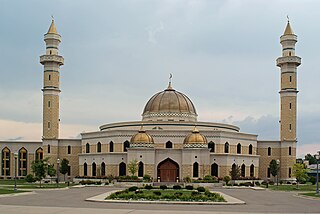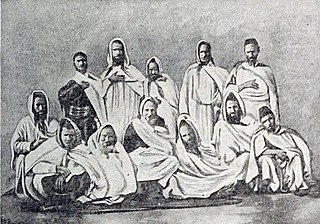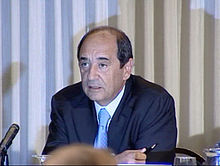In the 20th century, approximately 900000 Jews migrated, fled, or were expelled from Muslim-majority countries throughout Africa and Asia. Primarily a consequence of the 1948 Arab–Israeli War, the mass movement mainly transpired from 1948 to the early 1970s, with one final exodus of Iranian Jews occurring shortly after the Islamic Revolution in 1979–1980. An estimated 650000 (72%) of these Jews resettled in Israel.

Arab Americans are Americans of Arab ancestry. Arab Americans trace ancestry to any of the various waves of immigrants of the countries comprising the Arab World.

Tangier is a city in northwestern Morocco, on the coasts of the Mediterranean Sea and the Atlantic Ocean. The city is the capital of the Tanger-Tetouan-Al Hoceima region, as well as the Tangier-Assilah Prefecture of Morocco.

Islam is the third largest religion in the United States (1%), behind Christianity and Judaism (2%), and equaling the shares of Buddhism and Hinduism. A 2017 study estimated that 1.1% of the population of the United States are Muslim. In 2017, twenty states, mostly in the South and Midwest, reported Islam to be the largest non-Christian religion. In 2020, the U.S. Religion Census found there to be 4.45 million Muslim Americans, or roughly 1.3% of the population.

African Jewish communities include:

Maghrebi Jews or North African Jews are ethnic Jews who had traditionally lived in the Maghreb region of North Africa under Arab rule during the Middle Ages. Established Jewish communities had existed in North Africa long before the arrival of Sephardi Jews, expelled from Portugal and Spain. Due to proximity, the term 'Maghrebi Jews' sometimes refers to Egyptian Jews as well, even though there are important cultural differences between the history of Egyptian and Maghrebi Jews. These Jews originating from North Africa constitute the second largest Jewish diaspora group.
Mizrahi Jews, also known as Mizrahim (מִזְרָחִים) or Mizrachi (מִזְרָחִי) and alternatively referred to as Oriental Jews or Edot HaMizrach, are a grouping of Jewish communities comprising those who remained in the Land of Israel and those who existed in diaspora throughout and around the Middle East and North Africa (MENA) from biblical times into the modern era.
Jewish ethnic divisions refer to many distinctive communities within the world's Jewish population. Although considered a self-identifying ethnicity, there are distinct ethnic subdivisions among Jews, most of which are primarily the result of geographic branching from an originating Israelite population, mixing with local communities, and subsequent independent evolutions.

The history of Jews in Algeria goes back to Antiquity, although it is not possible to trace with any certainty the time and circumstances of the arrival of the first Jews in what is now Algeria. In any case, several waves of immigration helped to increase the population. There may have been Jews in Carthage and present-day Algeria before the Roman conquest, but the development of Jewish communities is linked to the Roman presence. Jewish revolts in Israel and Cyrenaica in the 1st and 2nd centuries certainly led to the arrival of Jewish immigrants from these regions. Jewish proselytizing among the Berbers is an established historical fact, but its importance remains debated.
Arab Jews is a term for Jews living in or originating from the Arab world. The term is politically contested, often by Zionists or by Jews with roots in the Arab world who prefer to be identified as Mizrahi Jews. Many left or were expelled from Arab countries in the decades following the founding of Israel in 1948, and took up residence in Israel, Western Europe, the United States and Latin America.

Moroccan Jews constitute an ancient community. Before the founding of the State of Israel in 1948, there were about 265,000 Jews in the country, which gave Morocco the largest Jewish community in the Muslim world, but by 2017 only 2,000 or so remain. Jews in Morocco, originally speakers of Berber languages, Judeo-Moroccan Arabic or Judaeo-Spanish, were the first in the country to adopt the French language in the mid-19th century, and unlike the Muslim population French remains the main language of members of the Jewish community there.

Christians in Morocco constitute less than 1% of the country's population of 33,600,000. Most of the Christian adherents are Catholic and Protestants.

Berber Jews are the Jewish communities of the Maghreb, in North Africa, who historically spoke Berber languages. Between 1950 and 1970 most emigrated to France, the United States, or Israel.

Moroccan Jews are Jews who live in or are from Morocco. Moroccan Jews constitute an ancient community dating to Roman times. Jews began immigrating to the region as early as 70 CE. They were later met by a second wave of migrants from the Iberian peninsula in the period which immediately preceded and followed the issuing of the 1492 Alhambra Decree, when Jews were expelled from Spain, and soon afterward, from Portugal. This second wave of immigrants changed Moroccan Jewry, which largely embraced the Andalusian Sephardic liturgy, to switch to a mostly Sephardic identity.
Senegalese Americans are an ethnic group of Americans of Senegalese descent. In the surveys of 2019, 18,091 people claimed to be of Senegalese origin or descent in the United States. However, many West Africans trafficked by enslavers to the United States were also of Senegalese origin. Thus many African Americans may also have some ancestors of this country.
The main religion in Morocco is Sunni Islam, which is also the state religion of the country. Officially, 99% of the population are Muslim, and virtually all of those are Sunni. The second-largest religion in the country is Christianity, but most Christians in Morocco are foreigners. There is a community of the Baháʼí Faith. Only a fraction of the former number of Maghrebi Jews have remained in the country, many having moved to Israel.
North African Americans are Americans with origins in the region of North Africa. This group includes Americans of Algerian, Egyptian, Libyan, Moroccan, and Tunisian descent.

The migration of Moroccan Jews to Israel has been made all over the centuries. Moroccan Jews in Israel have been the founders of many pioneer neighborhoods in Jerusalem, Tel Aviv, Haifa, Tiberias and others.
The Maghreb Association of North America (MANA), also called Assembly of the Maghreb is a North African-American organization Chicago-based whose goal is to help new immigrants from Maghreb to adapt to American life and maintain, in turn, the principles of Sunni Islam. The organization was founded by Moroccan and Algerian immigrants in 1989 and meets to Moroccans, Algerians, Libyans and Tunisian people living in Chicago area. The Assembly connected to Maghrebis people of different economic conditions.
The history of the Jews in Mali dates back to the 8th century CE. Today, around 1,000 descendants of Jews live in Mali, mostly in or near Timbuktu.















